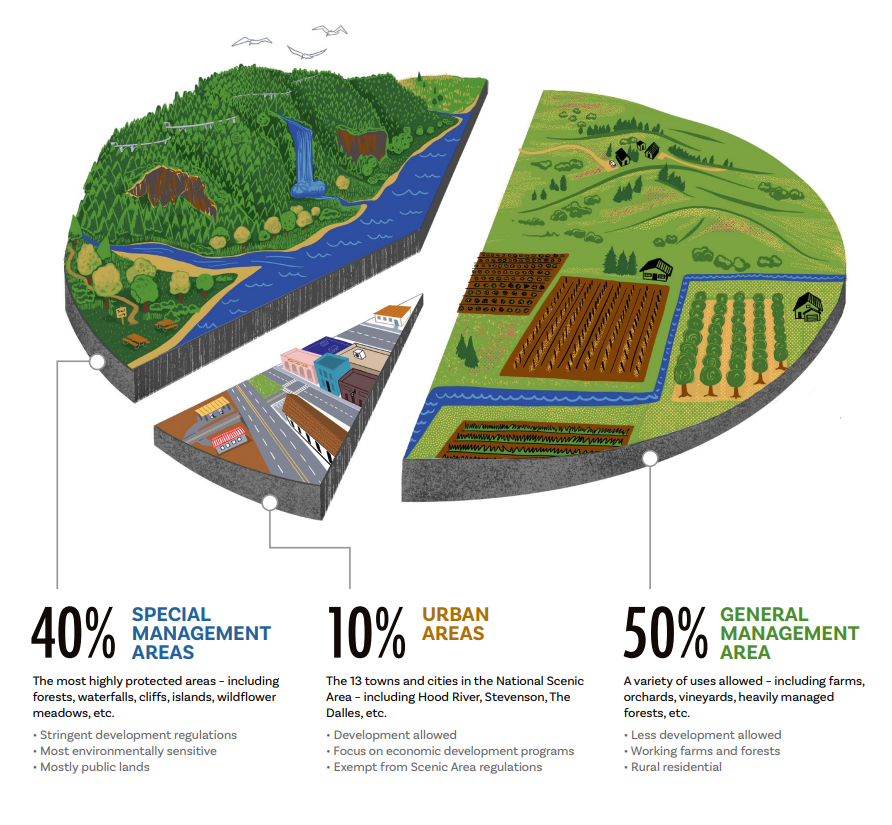Zoning designations are a bigger deal than you might think, especially in the Columbia Gorge. Under the recently revised Management Plan for the Columbia River Gorge National Scenic Area, the difference between small woodland, large woodland, and commercial forest land use designations is of critical importance for managing and protecting Gorge resources.

Why does it matter so much? We asked Michael Lang, who has been Friends' conservation director since 1995, to explain the importance of these carefully crafted designations and take us through a recent unsuccessful request by a landowner that the Columbia River Gorge Commission amend the Gorge Management Plan regarding the zoning of a Hood River County parcel.
Q: What are small and large woodland land use designations in the Columbia River Gorge National Scenic Area, and why are the distinctions important?
A: The National Scenic Area Act requires protection of forest land for forest uses and prohibits conversion to non-resource uses, like residential uses. The Large Woodland designation was put in place for this purpose and also to protect habitat and scenic, cultural, and recreation resources.
The Small Woodland designation is for lands that are capable of producing forests, and have really good soil and slopes, but are not as suitable for forestry for a number of reasons. These include being divided into a higher number of lots and in particular having more residential development. Residential uses can conflict with forest management, so you try to keep those uses separated. The Small Woodland zone has a smaller minimum lot size for land divisions, between 20 and 80 acres. New dwellings are allowed if the house is eligible for a forest tax deferral and has a forest management plan or, if you're not eligible for the tax deferral system in Oregon and Washington, you get one new dwelling anyway.
A big difference between the zones is that in Small Woodland zones, you get a dwelling. In Large Woodland Zones, under the previous Gorge Management Plan you got a dwelling only if it substantially contributes to ongoing forest management. Which was completely erroneous: No one needs a house in the forest to manage forest land. So during Gorge Management Plan revision (adopted by the Gorge Commission in late 2020, enacted in early 2021) Friends asked the Gorge Commission to prohibit new dwellings in the Large Woodland and Commercial Forest zones, because residential development doesn't contribute to forestry, it’s a conflicting use. This is especially true now with climate change and the increased frequency and intensity of wildfires, putting homeowners and emergency responders in harm's way. The commission agreed; under the revised Gorge Management Plan you can't have any new dwellings in Commercial Forest zones or Large Woodland zones.
Q: How did the landowner end up in front of the commission, asking for an amendment to the recently revised Gorge Management Plan?
A: The landowner found out that he was no longer eligible for the so-called forest dwelling so he applied for rezoning his 47.8-acre parcel as Small Woodland so he would potentially be eligible for a house on each of his seven tax lots. If approved, this would convert forest land to residential uses in violation of the Scenic Area Act and set an expectation for other forest land owners to be treated the same way. Friends submitted comments to the commission on the requested amendment pointing out that there are 20 total parcels in this particular, 172-acre Large Woodland zone. If this landowner got special treatment every other landowner in the zone could expect the same accommodation, leading to 15 more houses west of Hood River, right on the boundary of state and federal land. It would have had adverse impacts and also increased fire risk in the area.
Also, and we noted this in our comments, the landowner is currently carrying out forest management on the property. So it's hard to argue it's not suited to forestry while currently conducting forest management practices on it.
Q: How easy is it for individuals to propose amendments to the Gorge Management Plan and get them approved? How often does it happen?
A: It hasn't happened for at least 10 years and it's supposed to be difficult. The Scenic Area Act says that when there's a significant change in circumstances in the Scenic Area, the Gorge Management Plan may be amended. It's discretionary function of the Gorge Commission and it has the sole authority to amend the plan. The criteria for a plan amendment include a significant change in circumstances not anticipated when the Gorge Management Plan was last changed; the proposed amendment is consistent with the purposes and standards of the Scenic Area Act; and there's no practicable alternative to the proposed amendment that's more protective of resources.

Q: So resource protection trumps everything under the act?
A: Yes. And fortunately, the commission staff and Friends are in agreement on this issue and their excellent presentation at the Commission meeting helped persuade the commissioners to decline to process the proposed amendment.
If the landowner wants to continue pursuing a change in their land use designation they can request it during periodic review and revision of the Gorge Management Plan, where you don't have to show a significant change in circumstances. This landowner's request came after the last review of the Gorge Management Plan.
Q: This would underscore, then, the importance of citizens being aware and engaged during the long process of plan review.
A: Absolutely and landowners in the Scenic Area received ample notification of proposed changes in the Management Plan. There were over 40 public meetings over the course of four years where plan review was discussed. There were numerous public notices and public workshops held in Gorge counties through the course of plan review. The commission received thousands of comments from the public. In addition, Oregon requires notification by mail to landowners if zoning is going to become more restrictive on their property. Friends also notified its members and encouraged participation. In this case, the landowner testified that they were not aware of the zoning changes until after the final decisions were made. This has caused the Gorge Commission to begin examining new tactics to improve notification and public engagement opportunities. Friends supports these efforts to better engage people to participate in protecting the Columbia Gorge and planning for its future.


